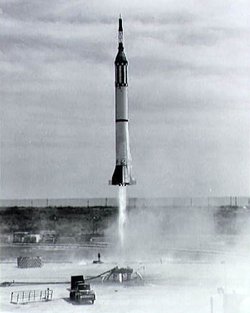Mercury-Redstone BD
|
|
| Mission Insignia | |
|---|---|

| |
| Mission Statistics | |
| Mission Name: | Mercury MR-BD |
| Call Sign: | MR-BD |
| Number of Crew Members: | 0 |
| Launch: | March 24, 1961 17:30 UTC Cape Canaveral Complex 5 |
| Landing: | March 24, 1961 17:08:23 |
| Duration: | 8 minutes, 23 seconds |
| Number of Orbits: | suborbital |
| Apogee: | 113.5 mi - 183 km |
| Distance Traveled: | 307 mi (494 km) |
| Maximum velocity: | 5,123 mph 8,245 km/h |
| Peak acceleration: | 11 g (108 m/s²) |
| Mass: | 1,141 kg |
| Mercury-Redstone BD | |
Mercury-Redstone BD was an unmanned Booster Development flight in the U.S. Mercury program. It was launched on March 24, 1961 from Launch Complex 5 at Cape Canaveral, Florida. The mission used a Boilerplate Mercury spacecraft and Redstone MRLV-5.
After the problems that developed during the Mercury-Redstone 2 mission that carried the chimpanzee Ham, it was apparent that the Redstone rocket needed further development before it could be trusted to carry a human passenger.
Dr. Wernher von Braun added Mercury-Redstone BD to the launch schedule between the Mercury-Redstone 2 and Mercury-Redstone 3 missions.
The cause of previous Redstone rocket over accelerations was a servo valve that didn't properly regulate the flow of hydrogen peroxide to the steam generator. This in turn overpowered the fuel pumps. The thrust regulator and velocity integrator were modified on the MR-BD and later Mercury-Redstone rockets to prevent them from exceeding the speed limit again.
Another problem encountered in previous Mercury-Redstone flights were harmonic vibrations induced by aerodynamic stress in the topmost section of the elongated Redstone. To fix this problem, four stiffeners were added to the ballast section and 210 pounds (95 kg) of insulation was applied to the inner skin of the upper part of the Mercury Redstone instrument compartment.
The mission used a boilerplate Mercury spacecraft, with inert escape rocket. The spacecraft also did not have a retro package or posigrade rockets.
The MR-BD mission lasted 8 minutes and 23 seconds. It reached an apogee of 113.5 miles (183 km) and a range of 307 miles (494 km). The peak velocity was 5,123 mph (8,245 km/h). The spacecraft experienced a peak load of 11 g (108 m/s²). There was no intention to separate the Redstone rocket and boilerplate Mercury spacecraft and they impacted together 307 miles (494 km) downrange, five miles (8 km) short of the plan. They sank to the bottom of the Atlantic Ocean, exploding a sofar bomb enroute.
MR-BD was highly successful and lead the way to the flight of Alan Shepard and Mercury 3.
Typical Mercury Redstone Sub-Orbital Flight Events
Not flight profile of Mercury-Redstone BD
| T+ Time | Event | Description |
| T+00:00:00 | Liftoff | Mercury-Redstone lifts off, onboard clock starts. |
| T+00:00:16 | Pitch Program | Redstone pitches over 2 deg/s from 90 deg to 45 deg. |
| T+00:00:40 | End Pitch Program | Redstone reaches 45 deg pitch. |
| T+00:01:24 | Max Q | Maximum dynamic pressure ~575 lbf/ft² (28 kPa). |
| T+00:02:20 | BECO | Redstone engine shutdown - Booster Engine Cutoff. Velocity 5,200 mph (2.3 km/s) |
| T+00:02:22 | Tower Jettison | Escape Tower Jettison, no longer needed. |
| T+00:02:24 | Capsule Separation | Posigrade rockets fire for 1 s giving 15 ft/s (4.6 m/s) separation. |
| T+00:02:35 | Turnaround Maneuver | Capsule (ASCS) system rotates capsule 180 degrees, to heat shield forward attitude. Nose is pitched down 34 degrees to retro fire position. |
| T+00:05:00 | Apogee | Apogee of about 115 miles (185 km) reached at 150 miles (240 km) downrange from launch site. |
| T+00:05:15 | Retrofire | Three retro rockets fire for 10 seconds each. They are started at 5 second intervals, firing overlaps. Delta V of 550 ft/s (168 m/s) is taken off forward velocity. |
| T+00:05:45 | Retract Periscope | Periscope is automatically retracted in preparation for reentry. |
| T+00:06:15 | Retro Pack Jettison | One minute after retrofire retro pack is jettisoned, leaving heatshield clear. |
| T+00:06:20 | Retro Attitude Maneuver | (ASCS) orients capsule in 34 degrees nose down pitch, 0 degrees roll, 0 degrees yaw. |
| T+00:07:15 | 0.05 g (0.49 m/s²) Maneuver | (ASCS) detects beginning of reentry and rolls capsule at 10 deg/s to stabilize capsule during reentry. |
| T+00:09:38 | Drogue Parachute Deploy | Drogue parachute deployed at 22,000 ft (6.7 km) slowing descent to 365 ft/s (111 m/s) and stabilizing capsule. |
| T+00:09:45 | Snorkel Deploy | Fresh air snorkel deploys at 20,000 ft (6 km). (ECS) switches to emergency oxygen rate to cool cabin. |
| T+00:10:15 | Main Parachute Deploy | Main parachute deploys at 10,000 ft (3 km). Descent rate slows to 30 ft/s (9 m/s) |
| T+00:10:20 | Landing Bag Deploy | Landing bag deploys, dropping heat shield down 4 ft (1.2 m). |
| T+00:10:20 | Fuel Dump | Remaining hydrogen peroxide fuel automatically dumped. |
| T+00:15:30 | Splashdown | Capsule lands in water about 300 mi (500 km) downrange from launch site. |
| T+00:15:30 | Rescue Aids Deploy | Rescue aid package deployed. The package includes green dye marker, recovery radio beacon and whip antenna. |
| Previous Mission: Little Joe 5A |
Mercury | Next Mission: Mercury-Atlas 3 |

